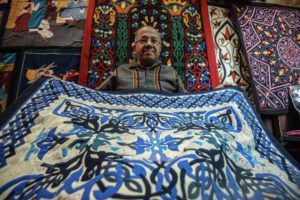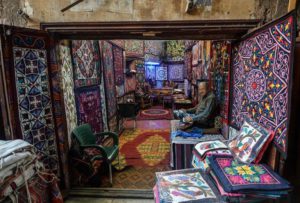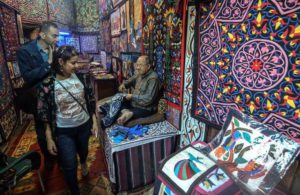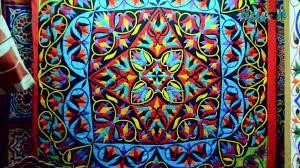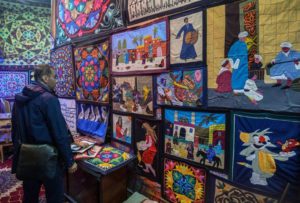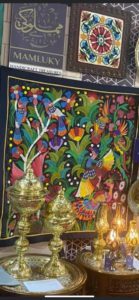Khyamia
Khyamaia word comes from the word Khaymy meaning a tent maker. It started as the craft of making and decorating tents. In older times, tents were very essential for travelling and throwing large celebrations. Perhaps the most famous tents in Egyptian history are those that were erected along the road from Cairo to Baghdad during the wedding trip of Princess “Qatr al-Nada”, the daughter of Khumarweh, the ruler of Egypt, which was set as an example – through the ages – of luxury and extravagance.
Over the years, and with the decreasing demand on tents, and as it developed as an art, it became common to use on different occasions, joyful or sad. It was used as Suan, (Pavilion) whether in weddings, ‘aza (accepting condolences), and for reciting Qur’an in Ramadan. They are also used in Mawlid (Musilm Saints’ day) to create small mobile pavillions for Aaragouz, cinemas and theaters. Nowadays, many decorative artefacts are also created using Khyamia, like bags, cushions, and wall hangings.
Khayameya is made from pieces of light cloth (such as Bafta, Troklin, and Satin) cut into different formations to create scenes from everyday life, folktales, scenes of Cairo, or Islamic and ancient Egyptian designs. Those pieces are distributed on Dacron (sailcloth); a thicker and more durable fabric; using coloured thread. A frame made of Arabic cotton named Nawwar strip, is also applied all around the piece. This process is, of course, is made manually using needle and thread, and the stich used is called magic stitch.
The most famous colours used are white, black, red, blue, green, orange, and yellow.
Decoration in Khyamia include:
- Calligraphy (Prayers, versus of the Qur’an, or words of wisdom)
- Animals, birds, and human figures
- Mamluk ranks (emblem indicating the status/job of the mamluk amir, or the emblem for the sultan
- Floral and geometric patterns


